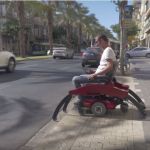“Then will the lame leap like a deer, and the mute tongue shout for joy. Water will gush forth in the wilderness and streams in the desert.” (Isaiah 35:6)
The Israeli company ReWalk, which invented a unique device that allows paraplegics to walk, has taken its expertise to the next level with UPnRIDE, a stand-up wheelchair specially designed for quadriplegics and those without full use of their arms and legs.
The ReWalk exoskeleton makes it possible for those paralyzed from the waist down to walk and even run again. But it requires the full use of one’s arms, so even its inventor, Dr. Amit Goffer is one of many quadriplegics who are unable to benefit from it.
Consequently, working with RehaMed Technologies’ CEO Oren Tamari, he came up with an even more comprehensive solution.
“When I worked at ReWalk, people, and particularly mothers, were calling in every day asking about the device for their handicapped child. It was so difficult for me to have to turn them away when they told me that their child was quadriplegic or had multiple sclerosis, because I knew that they couldn’t use it.
“The UPnRIDE is really the complementary product for ReWalk, providing a solution for all kinds of handicapped people,” said Tamari. (No Camels)
UPnRIDE is not meant to help someone walk again but, rather, to help them move and function in the world over various types of terrain from a standing position, in a similar fashion to the Segway or electric scooter.
A stand-up wheelchair is not new technology, but Tamari explains that the UPnRIDE has three key features that its predecessors in the industry do not:
“First, the UPnRIDE maintains the same center of gravity sitting and standing, making it harder to fall when standing up.
“Second, the user sits on a stabilized platform that is an ‘active stabilizer,’ automatically adjusting the angle of the seat to be vertical to the traveling surface.
“Finally, in emergency situations, UPnRIDE’s technology is able to identify when someone is likely to fall, releasing safety arms that are a lot like airbags in a car. These will catch the user as they fall and put them back in place on the device.”
With an R&D grant from Israel’s Technology Chief and key investors, UPnRIDE should be available for purchase in two years.
Some new “technologies,” however, don’t require such elaborate budgets and engineering resources to invent. They just need a lot of time, perseverance and love.
When Israeli mom Debby Elnatan learned that her son had cerebral palsy and would never be able to walk, she came up with a solution. Her harness device allows her son Rotem to walk in tandem with her while his hands are free to do other things.
She is even marketing the invention worldwide.
It’s called the Firefly Upsee Harness, which makes it possible for children with neuromuscular handicaps to both stand and move together with a supporting adult using shared sandals and a harness that attaches at the adult’s waist.
“The Upsee seems to give Emmy a sense of independence and empowerment, with the safety, comfort and confidence of having mom stand beside her,” says one Upsee mom. (FireflyFriends)
Although it is now best fitted to work with children between the ages of 3 and 8, there are plans for designs for older handicapped individuals. (No Camels)








